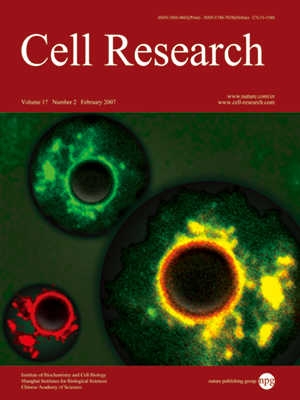
Volume 17, No 2, Feb 2007
ISSN: 1001-0602
EISSN: 1748-7838 2018
impact factor 17.848*
(Clarivate Analytics, 2019)
Volume 17 Issue 2, February 2007: 135-150
ORIGINAL ARTICLES
Nuclear reprogramming: the strategy used in normal development is also used in somatic cell nuclear transfer and parthenogenesis
Tianlong Gao1,*, Junke Zheng2,*, Fengying Xing2,*, Haiyan Fang2, Feng Sun1, Ayong Yan2, Xun Gong2, Hui Ding3,Fan Tang2, Hui Z Sheng2
1Program for Graduation Studies, Shanghai Institutes for Biological Sciences, Chinese Academy of Sciences, Shanghai 200031,
China; 2Center for Developmental Biology, Xinhua Hospital, Shanghai Jiao Tong University, School of Medicine, 1665 Kong Jiang
Road, Shanghai 200092, China; 3School of Animal Science and Technology, Yangzhou University, Yangzhou 225009, China
Correspondence: Hui Z Sheng(hzsheng2003@yahoo.com)
Somatic cell nuclear transfer (SCNT) and parthenogenesis are alternative forms of reproduction and development, building new life cycles on differentiated somatic cell nuclei and duplicated maternal chromatin, respectively. In the preceding paper (Sun F, et al., Cell Res 2007), we showed that an "erase-and-rebuild" strategy is used in normal development to transform the maternal gene expression profile to a zygotic one. Here, we investigate if the same strategy also applies to SCNT and parthenogenesis. The relationship between chromatin and chromatin factors (CFs) during SCNT and parthenogenesis was examined using immunochemical and GFP-fusion protein assays. Results from these studies indicated that soon after nuclear transfer, a majority of CFs dissociated from somatic nuclei and were redistributed to the cytoplasm of the egg. The erasure process in oogenesis is recaptured during the initial phase in SCNT. Most CFs entered pseudo-pronuclei shortly after their formation. In parthenogenesis, all parthenogenotes underwent normal oogenesis, and thus had removed most CFs from chromosomes before the initiation of development. The CFs were subsequently re-associated with female pronuclei in time and sequence similar to that in fertilized embryos. Based on these data, we conclude that the 揺rase-and-rebuild� process observed in normal development also occurs in SCNT and in parthenogenesis, albeit in altered fashions. The process is responsible for transcription reprogramming in these procedures. The "erase" process in SCNT is compressed and the efficiency is compromised, which likely contribute to the developmental defects often observed in nuclear transfer (nt) embryos. Furthermore, results from this study indicated that the cytoplasm of an egg contains most, if not all, essential components for assembling the zygotic program and can assemble them onto appropriate diploid chromatin of distinct origins.
Cell Research (2007) 17:135-150. doi: 10.1038/cr.2007.2; published online 6 February 2007
FULL TEXT | PDF
Browse 1715


